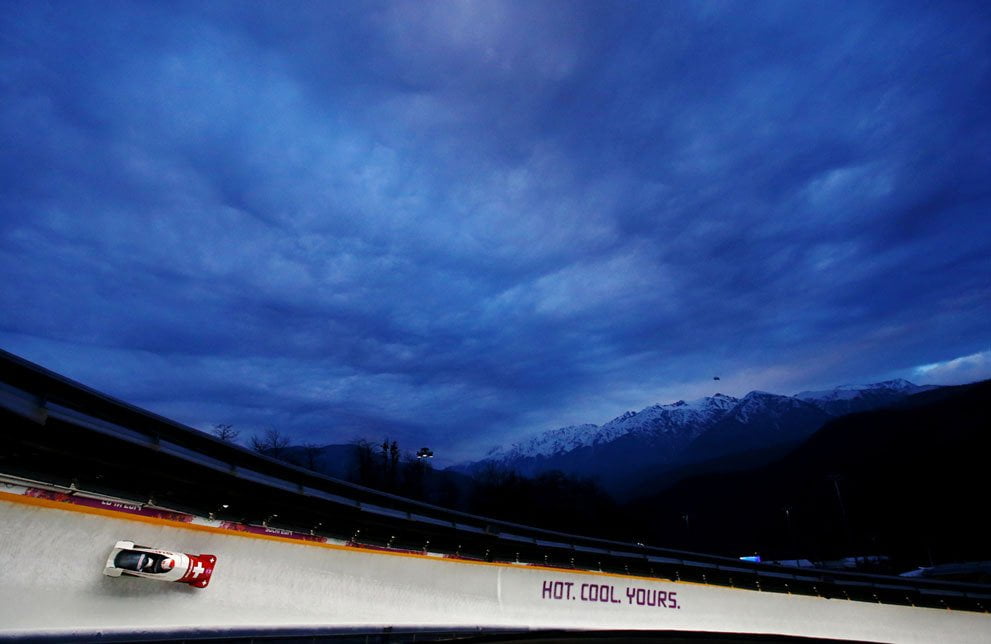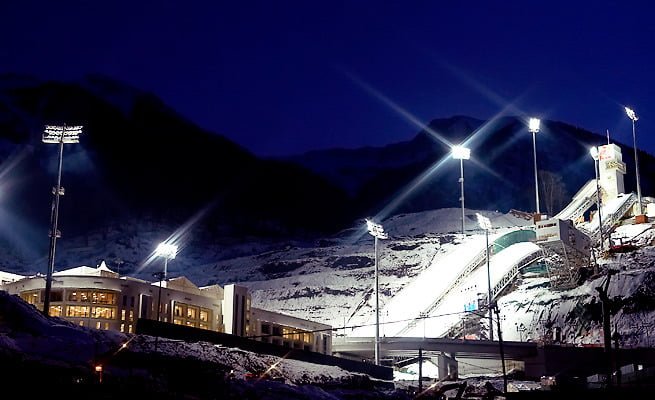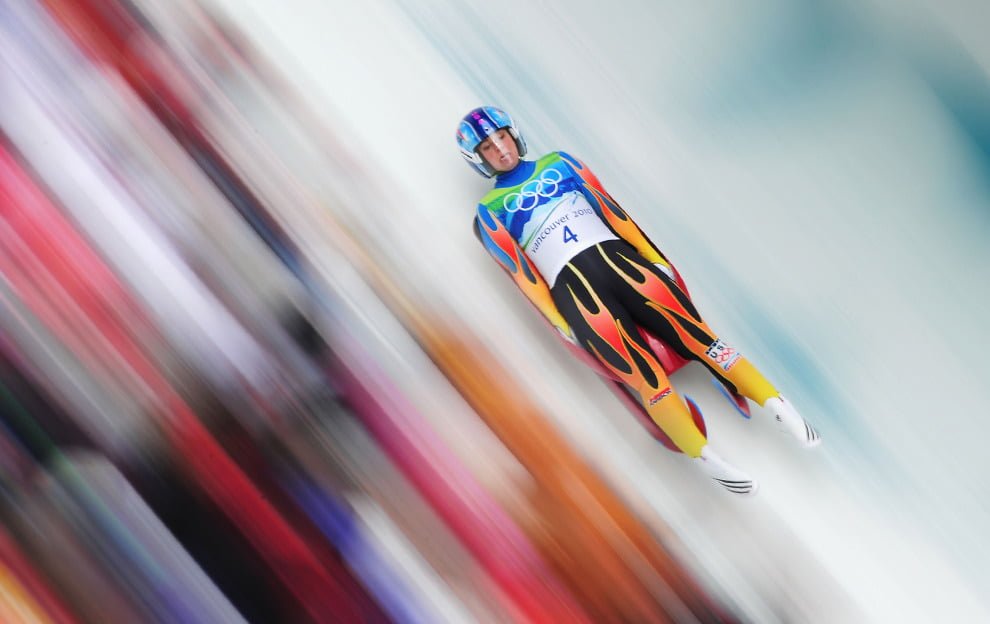Since 2006, Adidas has unveiled a new football design for each FIFA World Cup. This year’s ball, the Brazuca, is the first 6-panel ball and features glued panels instead of stitched ones. It also has a grippy surface covered in tiny nubs. Wind tunnel tests indicate the Brazuca experiences less drag than other recent low-panel-number footballs as well as less drag than a conventional 32-panel ball. Its stability and trajectory in flight are also more similar to a conventional ball than other recent World Cup balls, particularly the infamous Jabulani of the 2010 World Cup. The Brazuca’s similar flight performance relative to a conventional ball is likely due to its rough surface. Like the many stitched seams of a conventional football, the nubs on the Brazuca help trip flow around the ball to turbulence, much like dimples on a golf ball. Because the roughness is uniformly distributed, this transition is likely to happen simultaneously on all sides of the ball. Contrast this with a smooth, 8-panel football like the Jabulani; with fewer seams to trip flow on the ball, transition is uneven, causing a pressure imbalance across the ball that makes it change its trajectory. For more, be sure to check out the Brazuca articles at National Geographic and Popular Mechanics, as well as the original research article. (Photo credit: D. Karmann; research credit: S. Hong and T. Asai)
Tag: sports

Sochi 2014: Link Round-up
I’ve come across a lot of great links over the course of writing the #Sochi2014 series, and I want to highlight some of my favorites here. Be sure to check them out for some great behind-the-scenes looks at Olympic sport science and technology.
- Ski Racing covers the intriguing history behind speed suit development. Of particular interest is the development of Spyder’s Speedwyre suit, which featured a tripwire to induce turbulent flow. The suits were so effective at increasing skiers’ speeds that skiing’s governing body outlawed them ahead of the 1998 Olympics. There are similar restrictions in the speed suits of other sports, but sometimes people get away with it. (h/t @YvesDubief)
- A must-watch: Sir David Attenborough narrates curling.
- Smarter Every Day has had some awesome Olympics-themed infographics during the Games. Some favorites: how clapskates work, how to do an axel jump, an illustration of ski jumping, how curling stones curl, and the basics of curling.
- The National Science Foundation put together a whole series of videos on the science and engineering of the Winter Olympics.
- CBS goes inside the BMW redesign of the US bobsleds, luge, and skeleton sleds.
- Wired took an in-depth look at using science to improve an alpine skier’s performance.
- It’s originally from 2010, but SciAm has a neat podcast on the physics of curling. They also give some background on the granite in the stones, which comes from one particular island off Scotland.
- The distinctive V-style of ski jumping may have developed as a result of an athlete’s mid-air seizure. (via @YvesDubief)
- Inrng compares the aerodynamics of cycling and skiing, wondering if skiers are leaving precious tenths behind on the hill due to bulky equipment.
(Photo credit: A. Bello/Getty Images)

Sochi 2014: Speed Skiing
As FYFD wraps up coverage of #Sochi2014, let’s take a look at a winter sport not currently contested at the Olympics. This year’s Winter Games featured 12 new events. Speed skiing was not among them, though it was a demonstration sport in the 1992 Olympics. Like many of the sports in Sochi, speed skiing is gravity-driven, and friction and drag serve only to slow competitors. Speed skiing is about getting from the top of the course to the bottom, in a straight line, as fast as possible. Athletes reach velocities as high as 250 kph (155 mph), and aerodynamics are of the utmost concern. The skiers’ rubberized speed suits include airfoil-shaped fairings behind their calves that mold the airflow, and athletes wear giant aerodynamic helmets to smooth flow over their heads and shoulders. They spend their entire descent in an aerodynamic tuck, arms extended ahead of them like a cyclist in a time trial. It looks a pretty crazy ride. Would you like to see it added to the Olympics? (Video credit: R. Sill/University of Cambridge)
FYFD is celebrating #Sochi2014 with a look at fluid dynamics in winter sports. Check out the previous poss on why ice is slippery, the aerodynamics of speedskating, and how lugers slide fast.

Sochi 2014: Curling
Curling is rather unique among target-based sports because it allows athletes to alter the trajectory of their projectile after release. Curlers send 19 kg granite stones sliding across a pebbled ice surface at a target 28 meters away. On the way, teammates sweep the ice with natural or synthetic brushes. Sweeping the ice causes frictional heating, which lowers the local coefficient of friction and allows the stone to slide meters further than it would without sweeping. The bottom of the stone is concave, so the rock only contacts the ice along a narrow ring. One explanation for the stone’s tendency to curl in the direction it spins comes from this contact ring. Researchers suggest that the roughness of the leading edge cuts scratches into the ice which the trailing edge attempts to follow, causing the stone to move laterally, as illustrated over at Smarter Every Day. It’s important to note that the sweeping curlers do doesn’t directly guide the stone. In fact, by lowering the coefficient of friction the sweepers prevent the stone’s curling, and thus much of the skill of the sport is in knowing when, how, and how much to sweep. (Photo credit: C. Spencer/Getty Images)
FYFD is celebrating #Sochi2014 by studying the fluid dynamics of the Games. Check out some of our previous posts including how to make artificial snow, the aerodynamics of bobsledding, and how ski jumpers fly further.

Sochi 2014: Making Snow
Much attention ahead of the Sochi Winter Olympics has been dedicated to the question of how this subtropical resort town would provide and maintain adequate snow cover for the Games. Officials promised a combination of natural snow, snow transported from elsewhere, snow stored from the previous year, and, of course, artificial snow. These days many ski resorts rely heavily on snow guns producing artificial snow. There are two main types of snow gun–those which use compressed air and those which have an electrically-driven fan–but the principles behind each are the same. The snow guns provide a continuous spray of air and water, atomizing the water into tiny droplets which freeze rapidly. The effectiveness of snow guns depends on both the temperature and humidity of the surrounding air. With sufficiently dry air, artificial snow can be made even several degrees above freezing. Sochi itself is relatively humid (72% on average for February), but most of the outdoor events are held in Krasnaya Polyana, higher in the mountains where temperatures are typically much lower and artificial snow can be manufactured. That said, temperatures have reached as high as 15 degrees Celsius during the Games so far, and athletes have complained about the changing snow conditions in several events. (Video credit: On The Snow)
FYFD is celebrating #Sochi2014 with a look at the fluid dynamics of the Winter Games. Check out our previous posts, including how lugers slide fast, how wind affects ski jumpers, and why ice is slippery.

Sochi 2014: Ski Jump, Part 2
Yesterday we talked about the technique ski jumpers use to fly farther. Generating lift without too much drag is the key to a good jump. But jumpers are subject to ever-changing wind conditions, and those can help or hurt them. Unlike most sports, in ski jumping a headwind is desirable. This is because the added relative air velocity increases the jumper’s lift and helps them fly farther. A tailwind, on the other hand, saps their speed. Since 2009, ski jumping competitions have included a wind compensation factor that tries to account for these effects. Wind velocity is measured at five points along the jumper’s flight path and the tangential (i.e. head- or tailwind) components are weighted and averaged. The weighting factors seem to be individual to each hill – not all hills are built with the same profile. This average tangential wind speed is then a linear variable in an equation for wind factor. The goal of the wind factor is as much to make the competition run smoothly as it is to increase fairness. The trouble is that the wind speed effect is non-linear; in other words, a headwind does not help a jumper as much as a tailwind can hurt them. In one simulation study, researchers found a 3 m/s headwind carried jumpers 17.4 m further while a tailwind of the same magnitude shortened the jump by 29.1 m. The wind differences in competition may not be as drastic, but truly evening the playing field may require a more complicated compensation system. (Photo credit: B. Martin/Sports Illustrated)
FYFD is celebrating the Games with a look at fluid dynamics in the Winter Olympics. Check out our previous posts on the aerodynamics of speed skating, why ice is slippery and how lugers slide so fast.

Sochi 2014: Speedskating Suits
Long track speed skating is a race against the clock. Skaters reach speeds of roughly 50 kph, so drag has a significant impact. This is why skaters stay bent and spend straightaways–their fastest segments on the ice–with their arms pulled behind them. It’s also why their speedsuits have hoods to cover their hair. This year the U.S. speed skaters are wearing special suits designed by Under Armour and Lockheed Martin especially for their aerodynamics. The suits feature a mixture of fabrics including raised surface features on the hood and forearms. These bumps are designed to trip turbulent flow in these regions. It seems counterintuitive, but drag is actually lower for a turbulent boundary layer than a laminar one at the right Reynolds number range. This is because turbulent boundary layers are better at staying attached to non-streamlined bodies. The longer flow stays attached to the skater, the smaller the pressure difference between the air in front of the skater and the air in his wake. The suit’s seams and even its hot-rod-like flames were placed with this effect in mind. Only time will tell whether the suits really give skaters a competitive edge, but since Sochi’s low-altitude increases drag on skaters, they will appreciate some extra speed. For more, NSF has an inside look at the suit’s development. (Photo credits: Under Armour)
FYFD is exploring the fluid dynamics of the Winter Olympics. Check out previous posts on how lugers slide fast and why ice is slippery, and be sure to stay tuned for more!

Sochi 2014: Luge
Like athletes in many of the gravity sports in the Winter Olympics, lugers want to be as aerodynamic as possible to minimize their drag. Once a luger has started sliding, only gravity can increase their speed – every other force, from friction to drag, pulls away valuable time. Luge sleds are built on sharp runners and athletes slide feet-first in a position much more streamlined than the head-first position of skeleton. Both contribute to the much higher speeds in luge – up to 140 kph (87 mph). Luge is also the only sliding sport measured down to thousandths of a second, so every gram of drag* makes a difference. Lugers keep their heads pulled back and wear full helmets to keep the air flow consistent and attached as much as possible. It is also typical for them to spend time in the wind tunnel, testing their sled’s aerodynamics, adjusting their position, and even testing their suits. (Photo credit: S. Botterill)
* For those wondering, yes, drag is a force and a gram is a unit of mass, not force. However, it is not unusual when testing athletes in wind tunnels to compare drag between configurations in terms of grams.
FYFD is celebrating the Games with a series on fluid dynamics in the Winter Olympics. Stay tuned for more!

Sochi 2014: Why is Ice Slippery?
Ice is a key component of many Winter Olympic disciplines, including figure skating, hockey, speed skating, curling, and the sliding sports. The low friction and slippery nature of the ice are vital to the events, but oddly enough, scientists don’t yet fully understand why ice is slippery. A common explanation is that the narrow blades on which athletes compete cause extremely high pressures that locally melts the ice, creating a thin layer of water upon which the athlete glides. The trouble with this explanation is that it only accounts for ice being slippery within a few degrees of its melting point. Not only that, anyone who has fallen when walking on ice knows that it is slippery even without ice skates. In 1859 physicist Michael Faraday suggested that ice may be covered in a thin liquid-like layer even at temperatures well below freezing. Experiments since then suggest that this layer is tens or hundreds of nanometers thick, depending on the purity of the surface film. Robert Rosenberg has an excellent review of the subject in Physics Today. (Image credit: Reuters/D. Gray via The Big Picture)
This post opens up our series on fluid dynamics in the Winter Olympics. Stay tuned for more over the next two weeks. Got a question in mind? Seen a great article? Feel free to ask questions or submit links on Tumblr, Twitter, or by email.

Ski Jumping Aerodynamics
Last summer we featured fluid dynamics in the Summer Olympics and there’s more to come for Sochi. Winter athletes like ski jumper Sarah Hendrickson are hard at work preparing, which can include time in wind tunnels, as shown here. There are two main diagnostics in tests like these: drag measurements and smoke visualization. The board Hendrickson stands on is connected to the tunnel’s force balance, which allows engineers to measure the differences in drag on her as she adjusts equipment and positions. This gives a macroscopic measure of drag reduction, and reduced drag makes the skier faster on the snow and lets her fly longer in the jump. The smoke wand provides a way to visualize local flow conditions to ensure flow remains attached around the athlete, which also reduces drag. (Video credit: Red Bull/Outside Magazine; submitted by @YvesDubief)












